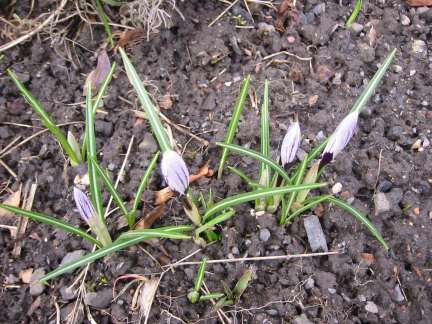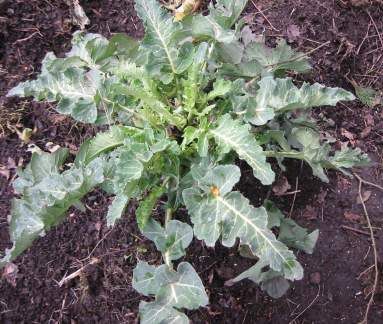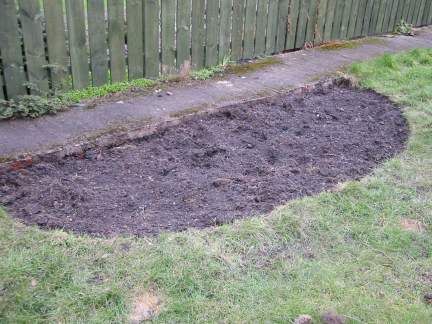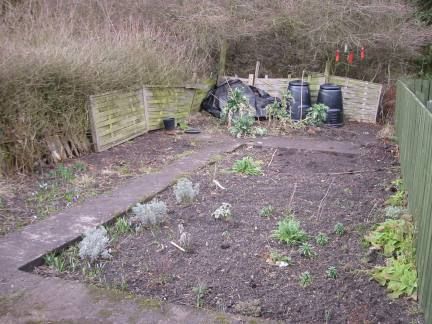March: A Month in the Garden

The gardener, on the whole, works with the rhythms of nature, in a cycle, and for us gardeners (and members of the Northern Hemisphere) our annual cycle starts right about now. March is the month that things start to really happen in the garden. The lawns grow, trees bud, weeds sprout, bulbs emerge and flower, bird song changes and everything starts to re-animate. In our garden the bulbs are all coming up, some of which I planted myself in the sunny December days we had, things like miniature drumstick alliums and two different types of miniature tulips. The garden came complete with beds full of daffodils, non-native bluebells (I am working on erradicating these) and crocuses, but only when they start to push their spring-green leaves up through the soil can the garden really start to begin its new year.

Spring has come late for us up here, there have been many days of rain, sleet, snow and hail, and still the temperature is much lower than this time last year, when the Fiancé and I spent days on the beach in the warm hazy sunshine. According to our neighbour who has lived on this street (and was born in our house!) all of his life, spring doesn't get here until around the beginning of April. For others it can be earlier, sometimes up to a month and half earlier if you live near Cornwall, Devon and the south-west. The things that we can start to do in the month of March do really depend on where you live and what time the weather starts to get better. Usually you can expect frosts until the middle of May for most places, but in the south it will be considerably earlier. It is worth watching the weather forecast as the old quote says: "the difference between a good gardener is two weeks". So from now on, watch the weather like a hawk, consider getting yourself an outside thermometer and become aware of your surroundings.
Seeing as March is typically the 'new year' for the garden, it is time to implement the planning from way back in October. You should by now have a good idea of planting arrangements, colour schemes, fruit/vegetable beds (if you're having them) and of jobs that need to be done in the garden. We dug our beds over at the end of last year, hoed them, and left them mainly fallow to allow the soil and worms to do their job, to open the soil up and give it better structure for the coming year's plants. I have divided our beds up into specific areas, to allow them to be practically useful, and to allow ease of movement. The aesthetics of the garden are still important too, so when planting I'll keep everything sympathetic to one another. We have 7 beds in total, and here are my plans for them:
- Top bed, sunny south-facing, gets majority of sun although in one corner it suffers from neighbouring a large hawthorn bush and also an unruly privet hedge. Our compost bins, Elthel (I mean, come on, who doesn't name their compost bins?! She looks like an Elthel, too!) and Florence, live there, as does the leaf-litter pile. Currently the bed is shared also by the purple-sprouting broccoli, which we have decided is probably not going to flower, although we'll give it until the beginning of April before we remove it and give up.

- Main veg bed, sunny location, south-facing, gets all the sun. Suffers from a slightly stony soil, which means in order to grow good root vegetables will need a healthy seiving before any seeds can be sown. This is a problem as rain has prevented much work on this level. This bed is split in half, with the other half being devoted to my wonderful herbs. The herb bed doesn't just house herbs, it has some small hardy shrubs like a bright-red geum 'Mrs. Bradshaw', spirea 'Gold Flame' and many native foxgloves and some wallflowers. It has three lavender plants which will form a scented hedge on the eastern side (bordering the path), fennel, thyme, oregano, tricolour sage, blackcurrant bush and lemon balm. The feel for this will be a cottage-garden, with native British wildflowers, poppies, sweet peas, love-in-a-mist 'nigella damascena' and cerynths. But will also retain the practicality for harvesting of the herbs themselves.
- Shady bed, running alongside the vegetable bed with a path inbetween, it neighbours a greedy privet hedge and is quite shaded. This bed will be home to anything that loves shade, or that can attain height. It isn't shady all of the time, in the morning and early afternoon it will have full sun. The plan for this is a buddleja davidii, a deep purple 'butterfly bush', a sweet pale-cream rhododendron and some roses. I'd like to hide some of that privet hedge and keep the interest focused on the main bed, but give some height, shade and colour to the garden in general.
- The bed which isn't. This is situated at the top of the lawn and through self-seeding before we bought the house reverted back into lawn. It will be another vegetable bed.

- Three semi-circluar beds, one small, one large, one small, in that order down the western side of the lawn. These will be the 'show' beds, full of annuals, bright flowers, just a mass of colour.
Planning things out like that enables me to be able to look closely, define the aim of the garden, and work with it. I don't say those plans will be strictly adhered to, but for me it helps greatly. On our wedding list there is a 'garden obelisk' and roses, the plan is to have some height in the garden by having an archway bordered either side by trellis, to give the garden some much-needed privacy.

[the top third of our garden as it is today, it looks barren, cold and rickety but when it is planted it'll come into a world of its own!]
In the garden this month:
- Finish planting roses and give established roses their spring pruning.
- Mend lawns, and if you get a dry week with warm temperatures, mow your lawn. Re-cut edges of lawns and re-seed if necessary.
- If you have a bare bed fertilise and prepare it for whatever you plan to grow in it.
- Get your hoe out and start attacking those perennial weeds before they become rampant. It will save many many hours in the summer if you get in there early.
- Scrub paths with a mild detergent and a good strong brush.
- Get your hands dirty - re-pot your potted perennials. If you haven't done so already, scrub out plastic pots ready for planting seeds (which should also be done now).
- Give some ericaceous fertiliser to your camelia, rhododendron or azealea as it starts to bud. Spent tea-bags, in moderate numbers (there can be too much of a good thing) will give your acid-lovers a boost.
- Give some love to your indoor houseplants. Re-pot if necessary, talk to, water and feed every plant in your house. Wipe leaves to remove dust with either a damp cotton-wool ball or a feather duster if delicate.
- Make friends with your compost heap, get one if you haven't already, and start saving all of your fruit scraps, vegetable scraps, shredded and soaked newspaper, spent tea-bags and coffee grounds, grass clippings, weeds, any garden waste except woody cuttings. Add an accelerator like Garotta and within a few months you'll be reaping the rewards of your labours!


















1 Comments:
I am very much inspired by your gardening expertise. I will be attempting to plant a few vegetables this year (if it ever warms up here)myself. Thanks for the motivation.
Post a Comment
<< Home